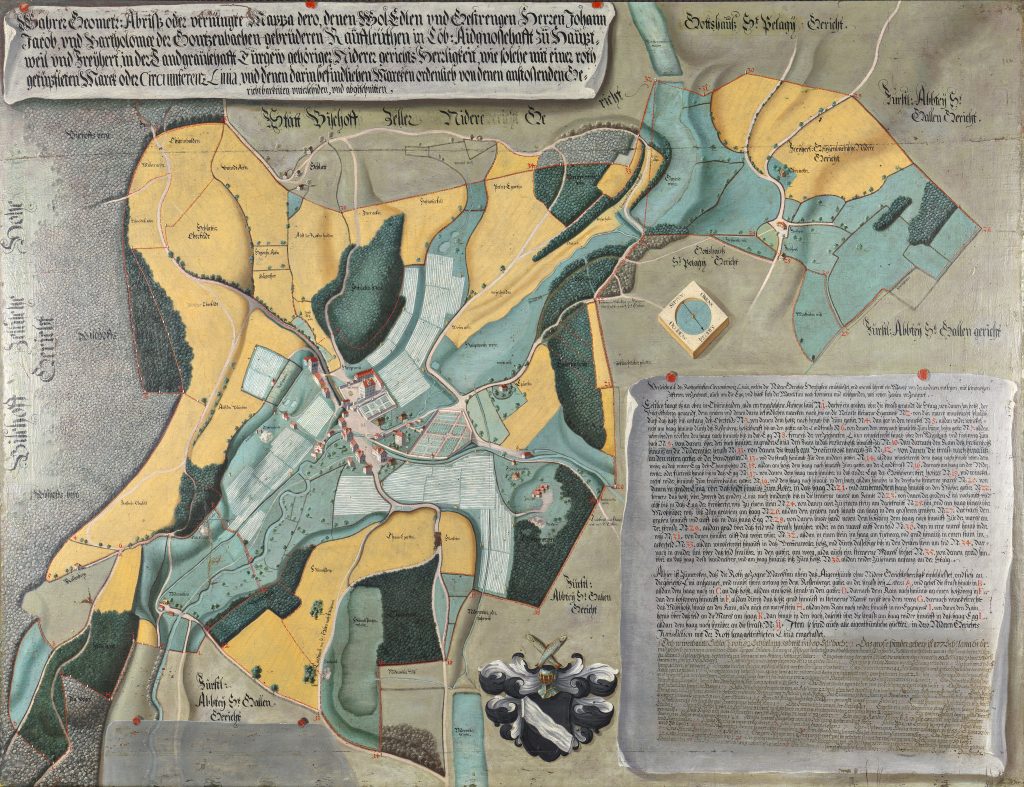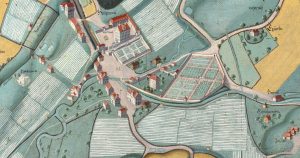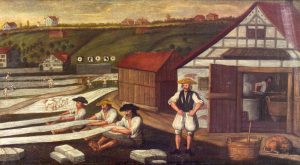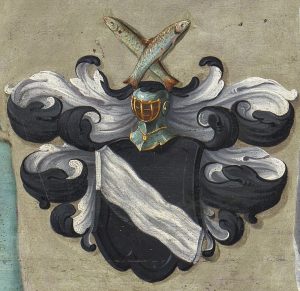MARCO TOMASZEWSKI

The image shown here is a veduta or map of the small village Hauptwil, located in Eastern Switzerland between St. Gallen and Lake Constance. When it was painted in 1670, this was a region of proto-industrial linen production with the city of St. Gallen as a main centre for trading, bleaching, and dyeing.[1] At that time, Hauptwil comprised about 40 buildings in which some 250 people lived and worked. There were two manor houses or little castles, two mills, three farms, an inn, a blacksmith’s shop and a sawmill. Most of the other buildings served the production and finishing of linen: there were two fulling mills, two mangling mills, dyeing shops, facilities and fields for bleaching (the white bleaching fields can be seen particularly well in the map), a press for preparing the shipment of the finished cloth as well as weaving cellars and accommodations.[2] All these buildings were owned by the brothers Hans Jacob and Bartholome Gonzenbach. They were wealthy merchants from nearby St. Gallen who exported linen mainly to Lyon, where they had a branch. In Hauptwil, they also owned the lordship of the land as well as the jurisdiction and thus held a quasi-aristocratic position.[3] What this map does not tell us is that in 1670 Hauptwil was an almost completely new settlement. Just ten years before, only one manor house, two mills, and three farms were there. Practically all of the inhabitants were newcomers, most from the surrounding area, and a few also from France and Swabia.
This extraordinary construction of a village as a production site within a few years and the impressive pictorial representation on the veduta are quite fascinating. In relation to the issue of freedom and work, however, the apparent intertwining of feudal and free elements in the organisation of textile production is of particular interest and can stimulate reflection on common concepts and pre-assumptions.

The Village as a Production Plant
The Gonzenbach started the construction of new buildings and facilities for the production, dyeing and bleaching of linen in Hauptwil from the 1650s. At that time, they already had some possessions and lordship rights there, which they consolidated and expanded further. During the 1660s they began to bleach linen in Hauptwil. Such an establishment of their own bleaching plant was not allowed within St. Gallen itself, since the council aimed to maintain a monopoly of the finishing of all linen cloth traded within the town. Furthermore, linen which was not purchased in St. Gallen was not allowed to be bleached there. However, many merchants, such as Hans Jacob and Bartholome Gonzenbach, traded with linen of different origin, from regions further afield. The Gonzenbach strove to allow the bleaching of linen from Swabia and Silesia in St. Gallen, but this was several times restricted by the council. As a consequence, they started to set up their own self-operated bleaching plant in Hauptwil. Finally, in 1666, after ongoing conflicts with the St. Gallen city council, Hans Jacob and Bartholome Gonzenbach gave up their burgher rights and moved to Hauptwil.
There, the lordship of Hauptwil and the Gonzenbach trading company were separate entities, although both were managed by Hans Jacob and Bartholome Gonzenbach in personal union. This becomes obvious in an income calculation of the lordship (“Income, profit, and expenses of Hauptwil”) which was set up by Hans Jacob in 1670 in order to calculate its future annual income.[4] All land, buildings, workshops, mills, and farmsteads belonged to the lordship and were rented to the inhabitants as well as to the trading company, who paid rent for them. Additionally, the trading company had to pay levies for bleaching to the lordship, which in return maintained the infrastructure of the bleaching facilities.
There were weavers in Hauptwil who made special cloths following the Dutch and French style. But these cloths only made up a small part of those bleached there. The focus of production was on bleaching and dyeing. Interestingly, by maintaining the facilities for the bleaching process by the lordship and financing this through the collection of levies (which were in turn paid by their own trading company), the system in Hauptwil was very similar to that in St. Gallen, where the bleaching plants were municipal facilities run by the municipal commune which also levied charges.

Freedom and Dependencies
It was freedom from corporative or municipal restrictions, which was the main motive for the Gonzenbach to develop Hauptwil into a production plant. This freedom went hand in hand with feudal rights and, partly, greater dependencies of the working people: on the one hand, the residents were free to move to Hauptwil and work there, and also to move away. On the other hand, to a large extent they were dependent on both the lordship and the trading company. They were at the same time subjects and tenants of Bartholome and Hans Jacob Gonzenbach, directly or indirectly employed by them, and economically dependent on them. This touched also the way of life of the working population, upon which the Gonzenbach also had an influence due to their political and legal power as judges and lords. In the preface to the funeral sermon for Hans Jacob Gonzenbach, for example, it is said that he hated ‘drunkenness / immoderateness / fornication / gambling, all arrogance, and other such vices / and would neither suffer nor tolerate such from his housemates / labourers and subjects’.[5]
Some characteristics of Gonzenbachs’ Hauptwil, built at great cost and risk within only a few years and combined with the settlement of a completely new population, could be considered exceptional. But what was not exceptional is that merchants used feudal lordship rights when engaging directly in textile production. On the contrary, the entanglement of free and feudal elements in rural proto-industrial production can often be observed.[6] However, there was no standard model for how these elements were combined. Instead, different cases reveal very different practices, which should be seen as decisions between different pre-modern options selected according to the framework conditions.[7]
This throws into question teleological pre-assumptions, such as the growth of freedom with capitalism, antagonisms between capitalism and feudalism, or status and contract.[8] Gonzenbachs’ freedom of trade was intertwined with feudal political, legal, and social privileges and rights. Far from breaking free from corporatist or feudal restrictions and leading to an unrestricted free market economy, what we can observe here should rather be understood as “freedoms” in the pre-modern meaning of privileges. This points to the distinction between etic and emic perspectives outlined out by Raffalea Sarti in the keynote discussion of the conference: freedom as an analytical category is not the same as the concept of freedom which we find in the premodern sources. Not least because of this latent ambiguity within the term freedom, the concept of dependencies could offer a useful analytical tool to study work and labour.[9]

Marco Tomaszewski is a research assistant in late medieval and early modern history at the University of Freiburg/Germany, having earned a PhD in 2013 with a study on sixteenth-century family books as media of urban communication. Research interests and publications include work/labour, social inequality, history of media and communication, memory culture and historiography, gender, periodisation concepts, and the Reformation. Current research project (funded by the DFG/German Research Foundation 2022-2025): Social and Cultural History of Proto-Industrial Labour. The Linen Industry of Eastern Switzerland, 1420–1720.
[1] For an overview and further references on the linen industry of Eastern Switzerland see Tomaszewski, Marco: Practices and Dependencies. Research Perspectives on the History of Proto-Industrial Labour and the St. Gallen Linen Industry (1450–1700), in: RiSES – Ricerche di storia economica e sociale (Journal of Economic and Social History) VI/1-2 (2020); Mayer, Marcel: Leinwand, in: Historisches Lexikon der Schweiz (HLS), 23.05.2012, https://hls-dhs-dss.ch/de/articles/013958/2012-05-23/ (last access: 12/07/2022); Göldi, Wolfgang et.al.: St. Gallen (Kanton), in: Historisches Lexikon der Schweiz (HLS), 11.05.2017, https://hls-dhs-dss.ch/de/articles/007390/2017-05-11/#HWirtschaft (last access: 12/07/2022).
[2] The text at the bottom right names the buildings that can be seen after describing the boundaries of the lower court district of Hauptwil (which is the main purpose of the map).
[3] For a detailed analysis of the history of Hauptwil and further references, see the work of Ernest Menolfi (on which the information in this blog post is largely based): Menolfi, Ernest: Frühes Unternehmertum in Hauptwil. Die Textilmanufakturen Gonzenbach im 17. und 18. Jahrhundert, Frauenfeld 2019; Menolfi, Ernest: Early Textile Printing in Eastern Switzerland and its Forgotten B(l)oom around 1800, in: Siebenhüner, Kim, John Jordan und Gabriele Schöpf (eds.): Cotton in Context. Manufacturing, Marketing, and Consuming Textiles in the German-speaking World (1500-1900), Wien/Köln/Weimar 2019; 119–144; Menolfi, Ernest: Hauptwil-Gottshaus – Geschichte eines Dorfes, Frauenfeld 2011.
[4] Museum Bischofszell, GoA 01’03, 5: Hauptwilisch Inkommen, nutz vnd beschwerde/ Verzeichniss des Hauptwylschen Einkommens.
[5] Anhorn von Hartwiss, Bartholomaeus: Christliche Leich-Predigt. Von dem herrlichen Nutzen der Anfechtungen und Trübsalen der Kinderen Gottes…: bey der … Leichbestattung, dess … Hanns Jacob Gonzenbach, … wie auch, der … Barbara am Stein, Mülhausen 1671 (Basel, UB, KiAr G V 14a:28), p. 12-13: “die Trunkenheit / Vnmässigheit / Vnzucht / Spielen, allen Ubermut, und andere dergleichen Laster gehasset / vnd solche an seinen Haußgenossen / Arbeitsleuten und Vnderthanen / weder leiden / noch dulden wollen.“
[6] Ogilvie, Sheilagh C.: Institutions and Economic Development in Early Modern Central Europe, in: Transactions of the Royal Historical Society 5 (1995), 221–250. For Silesia see recently Steffen, Anka: A cloth that binds. New perspectives on the eighteenth-century Prussian economy, in: Slavery & Abolition 42/1 (2021), 105–129.
[7] This fits to the concept of the early modern period as an age of ambiguity which was recently proposed by Thiessen, Hillard von: Das Zeitalter der Ambiguität. Vom Umgang mit Werten und Normen in der Frühen Neuzeit, Köln 2021.
[8] Trivellato, Francesca: Economic and Business History as Cultural History: Pitfalls and Possibilities, in: I Tatti Studies in the Italian Renaissance 22/2 (2019), 402–410, 405; Trivellato, Francesca: The Moral Economies of Early Modern Europe, in: Humanity: An International Journal of Human Rights, Humanitarianism, and Development 11/2 (2020), 193–201, 200.
[9] See De Vito, Christian G., Juliane Schiel and Matthias van Rossum: From Bondage to Precariousness? New Perspectives on Labor and Social History, in: Journal of Social History 54/2 (2020), 644–662, 648: “instead of focusing on production modes and labor relations alone, [they] propose to study modalities of domination and dependence, allowing for a more articulated conceptualization of social formations across time and space.”
